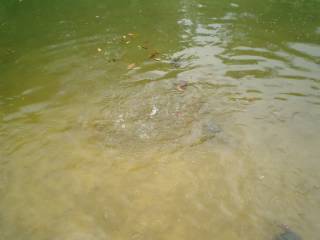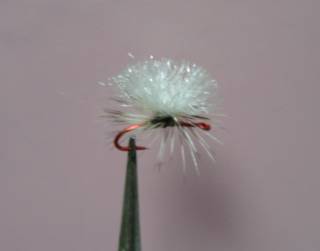Lampams at MacRitchie Reservoir

Lampam or Tin Foil Barb
Lampams are also known as Tinfoil Barbs (barbonymus schwanenfeldii) and is a natural species in the Singapore habitat. They were thought to be wiped out. But Lampams can still be seen at MacRitchie Reservoir in great numbers. Visitors to the park usually like to feed them with bread and enjoy watching the splashes made by their feeding.

Big splashes by a pod of Lampams feeding on bread
The schools of lampams are reported to have migrate all over the reservoir. Sometimes disappearing from the Fishing Ground for months. Fly fishermen who are more adventurous had reported finding this elusive fish at less accessible parts of the reservoir.
A little cove near the West Lake entrance to MacRitchie Reservoir Park is a favourite spot for lampan and people congregation. Most late afternoons old folks and young toddlers carrying bread and other aquarium fish food will gather at this cove to feed their favourite fish and terrapins. Rangers are also on hand to advise the visitors against this favourite past time.
A small cove near to West Lake entrance to McRitchie Reservoir
Stalking Lampams at MacRitchie Reservoir Lampams are greedy for easy meals like bread and fish food given by park visitors. So the easiest way to catch them is to chum the waters with bread and cast your fly into the feeding frenzy and hope for a hook-up. The lampam has a very small mouth. Flies used must also be small to improve catch rate.
A baby lampan on my own creation called "One-Step"
Easier said than done isn’t it. The moment you cast your line and started your retrive, all the lampans disappeared, as if a warning had been given. Many fly fishermen will tell you how spooky and smart this fish is.
What happened?
The positioning of your fly rod is spooking the lampams. I had observed many fly fishermen failed to catch this elusive lampam even though they had berleyed the place with enough bread to feed them for a week. They cast their lines and position their fly rods perpendicular to the edge of the waterline. The fly rod is casting a shadow into the water and the lampams are aware of it. Cast your fly line from a distant and position your fly rod parallel to the contour of the shoreline. This will prevent an unsightly shadow overhanging the lampams aiming to suck in your fly.
Keep the fly rod parallel to the shoreline
There is another more challenging method which I find more enjoyable. Again matching the hatch is the key to catching this spooky fish. The hatch in this instance is the humble Rubber Tree Flower. On windy days, rubber tree flowers fall like snow flakes into the water.
Lampams eating Rubber Ttree Flowers dropping onto the water
The lampams really love this food and they will snatch it just when they hit the water. This is the time when fly fishermen using the cream coloured caddis fly will hook fish after fish. Use a fine tippet. Be ready to strike when your fly hit the water.
Me?
I have my very own invention, a Rubber Tree Flower fly.
My very own Rubber Tree Flower fly

Lampam or Tin Foil Barb
Lampams are also known as Tinfoil Barbs (barbonymus schwanenfeldii) and is a natural species in the Singapore habitat. They were thought to be wiped out. But Lampams can still be seen at MacRitchie Reservoir in great numbers. Visitors to the park usually like to feed them with bread and enjoy watching the splashes made by their feeding.

Big splashes by a pod of Lampams feeding on bread
The schools of lampams are reported to have migrate all over the reservoir. Sometimes disappearing from the Fishing Ground for months. Fly fishermen who are more adventurous had reported finding this elusive fish at less accessible parts of the reservoir.
A little cove near the West Lake entrance to MacRitchie Reservoir Park is a favourite spot for lampan and people congregation. Most late afternoons old folks and young toddlers carrying bread and other aquarium fish food will gather at this cove to feed their favourite fish and terrapins. Rangers are also on hand to advise the visitors against this favourite past time.

A small cove near to West Lake entrance to McRitchie Reservoir
Stalking Lampams at MacRitchie Reservoir Lampams are greedy for easy meals like bread and fish food given by park visitors. So the easiest way to catch them is to chum the waters with bread and cast your fly into the feeding frenzy and hope for a hook-up. The lampam has a very small mouth. Flies used must also be small to improve catch rate.

A baby lampan on my own creation called "One-Step"
Easier said than done isn’t it. The moment you cast your line and started your retrive, all the lampans disappeared, as if a warning had been given. Many fly fishermen will tell you how spooky and smart this fish is.
What happened?
The positioning of your fly rod is spooking the lampams. I had observed many fly fishermen failed to catch this elusive lampam even though they had berleyed the place with enough bread to feed them for a week. They cast their lines and position their fly rods perpendicular to the edge of the waterline. The fly rod is casting a shadow into the water and the lampams are aware of it. Cast your fly line from a distant and position your fly rod parallel to the contour of the shoreline. This will prevent an unsightly shadow overhanging the lampams aiming to suck in your fly.

Keep the fly rod parallel to the shoreline
There is another more challenging method which I find more enjoyable. Again matching the hatch is the key to catching this spooky fish. The hatch in this instance is the humble Rubber Tree Flower. On windy days, rubber tree flowers fall like snow flakes into the water.

Lampams eating Rubber Ttree Flowers dropping onto the water
The lampams really love this food and they will snatch it just when they hit the water. This is the time when fly fishermen using the cream coloured caddis fly will hook fish after fish. Use a fine tippet. Be ready to strike when your fly hit the water.
Me?
I have my very own invention, a Rubber Tree Flower fly.

My very own Rubber Tree Flower fly

No comments:
Post a Comment